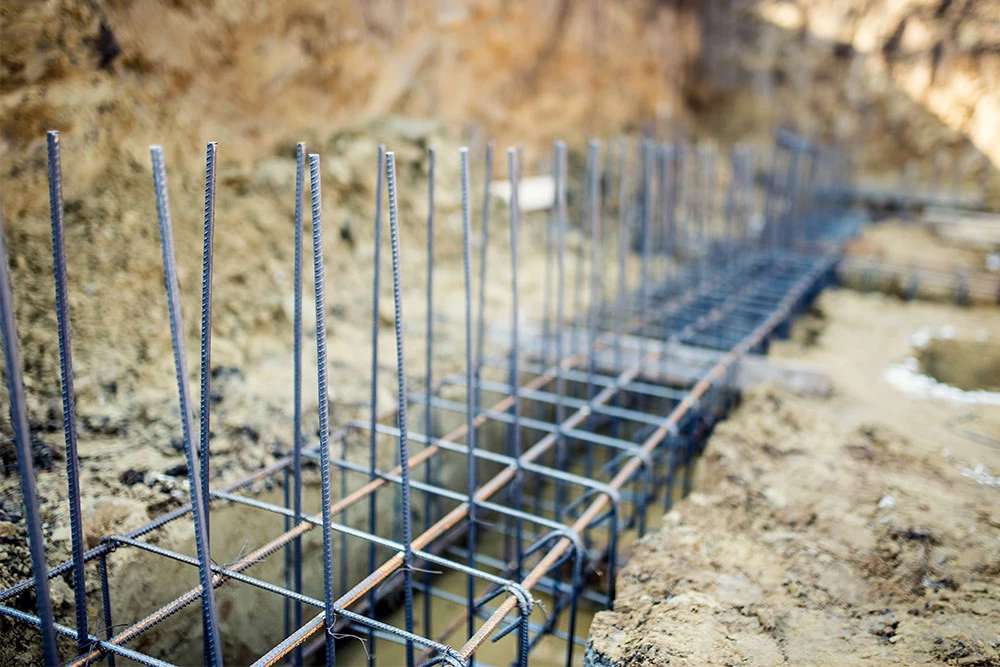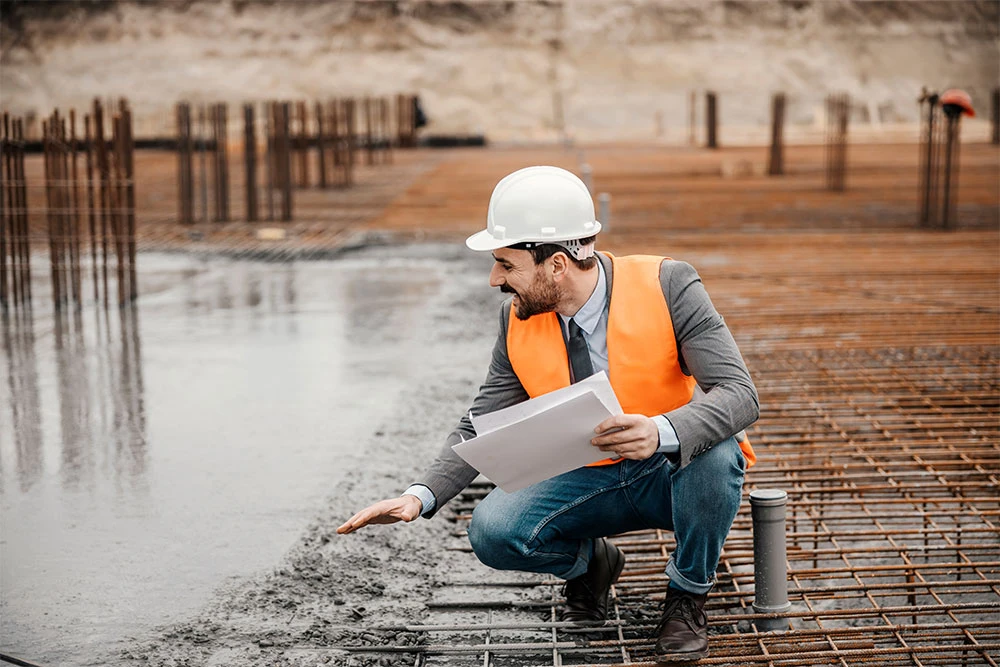1.1 Introduction to Foundation Engineering

Welcome to the intricate realm of foundation engineering – a field that ensures our structures stand tall and unwavering.
When it comes to construction, the only way to build a safe and stable building is to begin from the ground up, quite literally. Foundation engineering is the art of ensuring the building has a solid base and can withstand the stresses brought onto it by its ever-changing natural host.
Whether it’s a towering skyscraper or a cozy family home, the foundation is the main point of contact between a building and nature. Understanding the intricacies of foundation engineering is essential for both professionals in the field and building owners intent on preserving what is likely their most valuable asset.
Foundation issues can arise due to various factors such as changes in soil conditions, minor construction defects or more significant natural events such as earthquakes or flooding. The role of a foundation engineer is to assess the conditions of a site and use their experience and intuition to Identify and address these issues effectively.
Structural engineers employ advanced techniques such as structural analysis, inspection and even sonar to assess the condition of existing foundations and propose effective solutions.
1.2 The Importance of Foundation Engineering in Residential and Commercial Buildings
Your building foundation is the main point of interaction between the built form and nature. Foundation engineering is really the art of making this dynamic relationship work over time.
As with any relationship, the conditions often change compared to that of the initial interaction. Today, foundation engineer’s are not only focussed on designing new structures, but are skilled at effecting repairs and retrofitting custom solutions to extend your buildings longevity.
If you notice some minor defects or changes in your building’s structure there is no need to panic. Simply contact your local structural engineer and request an inspection. They’ll be sure to have an ideal solution, and it won’t even cost you a fortune.
Preserving Value
Your building is likely your most valuable fixed asset and can certainly be the most expensive to maintain. The best way to preserve the value of this asset is to continuously monitor the structure and effect repairs as soon as problems start to appear.
This is especially true for Engineering foundation repair solutions as there are several inexpensive options available for foundation design and repair work, however once the problem escalates to having a serious impact on the structure, you may be stuck with a significant structural repair job on your hands, or worse.
In the case of structural integrity, things can get much worse, for example total structural failure or collapse, which will have a major negative impact on the value of your building.
1.3 Roles of Structural Engineers in designing different types of footings
A Structural engineer plays a pivotal role in foundation design, employing their expertise to create a robust and resilient foundation system. From assessing soil conditions to determining suitable foundation types, their contributions are invaluable.
A foundation engineer conducts thorough analyses to ensure the proposed foundation system meets all necessary criteria for stability and safety. This involves assessing the anticipated loads, conducting soil testing, and considering any site-specific challenges.
By leveraging their extensive experience and expertise, engineers develop robust foundation designs capable of withstanding the test of time.
1.4 Types of Foundations for Different Soil Conditions
Different soil conditions require different types of foundations to ensure structural integrity. Spread footing, shallow foundation, and deep foundation such as a pile foundation are among the common types utilized in construction projects.
Different types of foundations are employed based on soil conditions and project specifications. Spread footings, shallow foundations, and deep foundations such as pile foundations are among the common types utilized.
Each foundation type is designed to distribute loads efficiently and prevent issues like differential settlement, which can compromise the structural integrity of buildings.
1.5 Key Considerations in residential foundation engineering
Whether it’s a spread footing, a shallow foundation, a deep foundation or a combined footing, the structural design involves various considerations. These include soil properties, building load requirements, and environmental factors. a Structural engineer will conduct thorough analyses to develop foundation systems capable of withstanding anticipated loads and environmental challenges.
Foundation engineering encompasses an important aspect in the stability and safety of structures. Residential and commercial buildings alike require meticulous planning and execution of a foundation system to withstand loads and environmental factors.
Structural engineers play a pivotal role in this process, employing their expertise to design suitable foundation elements tailored to each unique project.
1.6 Soil Properties and Their Influence on Foundation Engineering
Soil properties play a crucial role in foundation engineering, influencing the design and performance of a foundation system. Factors such as soil type, bearing capacity, and moisture content must be carefully evaluated to ensure the stability and longevity of structures.
The choice of foundation is heavily influenced by soil properties, including bearing capacity, soil type, and moisture content.
Geotechnical engineering plays a crucial role in analyzing soil characteristics and determining suitable foundation designs. Factors such as project location, environmental conditions, and anticipated loads also inform the foundation design process.
Section 2: Designing Suitable Foundations for New Buildings

2.1 Introduction to Foundation Design
In the intricate landscape of construction, stability and safety are rooted in the depths of foundation design. Foundation engineering, the bedrock of structural integrity, ensures that our buildings withstand the tests of time and environment.
Foundation design is a critical phase in the construction process, laying the groundwork for the structural integrity of buildings. Various factors, including soil properties, project requirements, and environmental conditions, must be carefully considered to develop a suitable foundation system.
2.2 Factors Influencing Foundation Design
Navigating the complexities of foundation design requires a keen understanding of various factors that influence structural stability. From soil properties to project specifications, every aspect plays a crucial role in determining the most suitable foundation system.
2.3 Types of Foundations and Their Applications
Diverse soil conditions demand tailored solutions in foundation design. Spread footings, shallow foundations, and deep foundations such as pile foundations each serve specific purposes, distributing loads efficiently and ensuring structural resilience.
2.3.1 Deep Foundations: Understanding Pile Foundations
In regions with challenging soil conditions, deep foundations emerge as stalwart solutions. Pile foundations, driven deep into the earth, provide stability by transferring building loads to more competent soil layers, safeguarding structures against settlement and instability.
2.3.2 Shallow Foundations: Spread Footings and Combined Footings
Where soil conditions permit, shallow foundations offer practical alternatives. Spread footings and combined footings disperse loads over a broader area, mitigating soil pressure and minimizing settlement risks, thus ensuring the stability of structures.
2.3.3 Concrete Slabs: Understanding the Varieties
Concrete slabs are a fundamental element in construction, providing sturdy foundations for a wide range of structures. Two primary types of concrete slabs are commonly used: slab on grade and structural slabs. Each type serves specific purposes in construction projects, offering distinct advantages and applications.
Slab on Grade
A slab on grade, as the name suggests, is a concrete slab that is directly poured onto the ground, typically without any basement or crawlspace beneath. This type of foundation is commonly used in residential construction, where the ground is sufficiently compacted to support the weight of the structure. Slabs on grade offer simplicity and cost-effectiveness, providing a stable base for buildings while minimizing excavation and construction time. They are well-suited for flat sites with stable soil conditions, where frost heave and expansive soil movement are not significant concerns.
Structural Slab
In contrast to slabs on grade, structural slabs are designed to support heavy loads and provide additional structural strength to a building. These slabs are typically thicker and reinforced with steel bars to withstand the stresses imposed by the building’s weight and usage. Structural slabs are commonly used in commercial and industrial construction, where larger spans and heavier loads are prevalent. They are essential for supporting multistory buildings, bridges, parking garages, and other structures where enhanced structural integrity is required.
Types of Structural Slabs
- Flat Plate Slab
- Flat Slab
- Waffle Slab
- Ribbed Slab
- Two-way Slab
- One-way Slab
- Post-Tensioned Slab
- Prestressed Slab
Each type of structural slab offers unique advantages in terms of load-bearing capacity, construction complexity, and cost-effectiveness. The choice of structural slab depends on factors such as building design, budget constraints, and project requirements
2.5 Foundation Walls
Now that your foundation is in, what happens next? foundation walls stabilize the structure against lateral pressures exerted by surrounding soil. The earth around the building is constantly moving as the earth’s surface changes over time. These changes can be over hundreds of years or as abrupt as a floor or an earthquake.
Foundation design is an art and a science, requiring a delicate balance of technical expertise and creative problem-solving. By meticulously analyzing soil conditions, anticipating loads, and leveraging innovative design techniques, structural engineers craft foundation systems that adapt to the conditions around them. This may not be a perfect science but don’t fret, there are many ways to fix and enhance the strength of existing foundations.
Section 3: Inspecting and Assessing Existing Foundations
3.1 Introduction to Foundation Inspection
Peering beneath the surface, foundation inspection unveils the hidden truths of structural integrity. In the ever-evolving landscape of construction, the careful scrutiny of existing foundations is paramount to ensuring the safety and longevity of buildings.
Foundation inspections involve a comprehensive evaluation of the structure’s foundation and surrounding soil conditions.
A Structural engineer utilizes various techniques, including visual inspections, geotechnical testing, and structural analysis, to assess the condition of the foundation. Signs of foundation issues, such as cracks in walls, uneven floors, or doors/windows that no longer close properly, may indicate underlying problems.
3.2 Common Foundation Issues and Causes
In the intricate dance between structure and soil, foundation issues may arise due to a myriad of factors. Inadequate design, changes in soil conditions, or construction defects can manifest as settlement, cracking, or moisture-related damage, posing threats to structural stability and integrity.
3.3 Structural Assessment Techniques
Unlocking the secrets buried beneath the earth’s surface requires a blend of artistry and science. Structural engineers deploy advanced assessment techniques, including structural analysis and non-destructive testing, to unveil the hidden vulnerabilities and intricacies of existing foundations.
3.4 Identifying Signs of Foundation Problems
In the silent language of structural distress, subtle cues often reveal profound truths. From hairline cracks to uneven settlement, identifying signs of foundation problems requires a keen eye and a deep understanding of structural behavior, enabling engineers to diagnose underlying issues accurately.
3.5 Differential Settlement: Causes and Consequences
In the delicate equilibrium between structure and soil, the phenomenon of differential settlement looms as a silent threat. Differential settlement, characterized by uneven settling of the foundation, can lead to structural instability and damage, posing significant risks to the safety and longevity of buildings.
3.6 Proposing Solutions to Damaged Foundations
In the crucible of adversity, innovation and expertise converge to forge solutions that stand the test of time. Structural engineers, armed with extensive experience and technical prowess, develop remediation plans tailored to the specific needs of each project, addressing underlying issues and restoring structural integrity.
Foundation issues can arise due to various factors, including inadequate design, changes in soil conditions, or construction defects.
Identifying and addressing these issues promptly is essential to prevent further damage to the structure. Structural engineers employ advanced techniques such as structural analysis and inspection to assess the condition of existing foundations and propose effective solutions.
In conclusion, inspecting and assessing existing foundations is essential for identifying and addressing potential structural problems.
By understanding the common issues affecting foundations and proposing tailored solutions, structural engineers play a vital role in ensuring the safety and stability of existing buildings.
With proper assessment and professional expertise, damaged foundations can be restored to their original condition, preserving the integrity of the structure for years to come.





